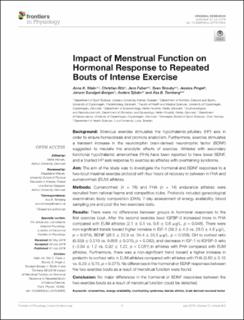Impact of menstrual function on hormonal response to repeated bouts of intense exercise
Melin, Anna Katarina; Ritz, Christian; Faber, Jens; Skouby, Sven; Pingel, Jessica; Sundgot-Borgen, Jorunn; Sjödin, Anders; Tornberg, Åsa B
Peer reviewed, Journal article
Published version
Permanent lenke
https://hdl.handle.net/11250/2653188Utgivelsesdato
2019Metadata
Vis full innførselSamlinger
- Artikler / Articles [2119]
- Publikasjoner fra Cristin [1107]
Sammendrag
Background: Strenous exercise stimulates the hypothalamic-pituitary (HP) axis in order to ensure homeostasis and promote anabolism. Furthermore, exercise stimulates a transient increase in the neurotrophin brain-derived neurotrophic factor (BDNF) suggested to mediate the anxiolytic effects of exercise. Athletes with secondary functional hypothalamic amenorrhea (FHA) have been reported to have lower BDNF, and a blunted HP axis response to exercise as athletes with overtraining syndrome. Aim: The aim of the study was to investigate the hormonal and BDNF responses to a two-bout maximal exercise protocol with four hours of recovery in between in FHA and eumenorrheic (EUM) athletes. Methods: Eumenorrheic (n = 16) and FHA (n = 14) endurance athletes were recruited from national teams and competitive clubs. Protocols included gynecological examination; body composition (DXA); 7-day assessment of energy availability; blood sampling pre and post the two exercises tests. Results: There were no differences between groups in hormonal responses to the first exercise bout. After the second exercise bout IGFBP-3 increased more in FHA compared with EUM athletes (2.1 ± 0.5 vs. 0.6 ± 0.6 μg/L, p = 0.048). There were non-significant trends toward higher increase in IGF-1 (39.3 ± 4.3 vs. 28.0 ± 4.6 μg/L, p = 0.074), BDNF (96.5 ± 22.9 vs. 34.4 ± 23.5 μg/L, p = 0.058), GH to cortisol ratio (0.329 ± 0.010 vs. 0.058 ± 0.010, p = 0.082), and decrease in IGF-1 to IGFBP-3 ratio (−2.04 ± 1.2 vs. 0.92 ± 1.22, p = 0.081) in athletes with FHA compared with EUM athletes. Furthermore, there was a non-significant trend toward a higher increase in prolactin to cortisol ratio in EUM athletes compared with athletes with FHA (0.60 ± 0.15 vs. 0.23 ± 0.15, p = 0.071). No differences in the hormonal or BDNF responses between the two exercise bouts as a result of menstrual function were found. Conclusion: No major differences in the hormonal or BDNF responses between the two exercise bouts as a result of menstrual function could be detected.
Beskrivelse
This is an open-access article distributed under the terms of the Creative Commons Attribution License (CC BY). The use, distribution or reproduction in other forums is permitted, provided the original author(s) and the copyright owner(s) are credited and that the original publication in this journal is cited, in accordance with accepted academic practice. No use, distribution or reproduction is permitted which does not comply with these terms.
